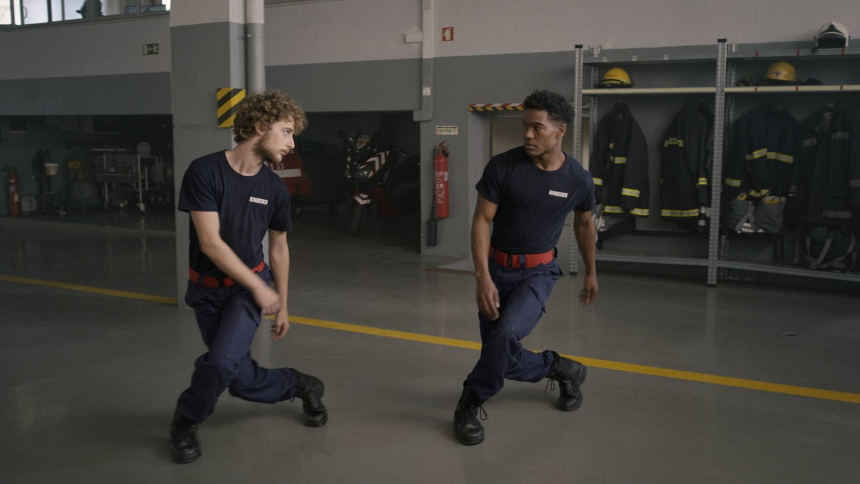New York 2022 Review: WILL-O'-THE-WISP, Exuberant Gay Fantasia
João Pedro Rodrigues' Portuguese musical delivers the dance numbers along with a side of environmentalism.

Considerable ink in recent months has been devoted to how Bros (2022), starring Billy Eichner, is the rare audience-friendly, happy gay rom-com. Consider João Pedro Rodrigues’s Will-o'-the-Wisp to be the art-house equivalent. This brief (at 67 minutes), exuberant musical stuck out as an oasis amidst the dour, lengthy movies at the Cannes Film Festival this year. It has been a fun counter-programming option at film festivals ever since.
Will-o'-the-Wisp (Fogo-Fátuo in Portuguese) chronicles the inter-racial dalliance between a white aristocrat and a Black firefighter. The Portuguese monarchy has been dead since 1910 but in Rodrigues’s vision, it is alive and well in the year 2011.
Alfredo (Mauro Costa) the young prince, against the wishes of his parents, the King and Queen, decides to join the local fire station as an apprentice, out of his concern for the environment, especially forest fires that might destroy the beautiful forests of Portugal one day. The rough and rowdy men of the fire station scoff at the prospect of this frail rich kid wanting to be a firefighter and much hazing ensues. It is here that sparks fly between Prince Alfredo and Afonso (André Cabral), the hunky Black firefighter assigned to train him.
The simplicity of the storyline gives Will-o'-the-Wisp plenty of room to include commentary on environmental preservation, race, and art, all interspersed with well-staged set pieces and musical numbers. There are actually only two songs performed at length in the film.
The first is “Uma Árvore um Amigo” (“A Tree, A Friend”) which is a popular children’s song from the 1980s that teaches kids about the importance of the environment. It is performed by about two dozen children in a forest. The second is what might be deemed the film’s big production number, as it has our two romantic leads dancing with about two dozen background firefighters to the Portuguese pop song “ctrl + C ctrl + V”, with the choreography based on actual firefighter moves.
Rodrigues is first and foremost a queer artist and homoerotic imagery abounds, especially in some of the major set pieces. Prince Alfredo is an art student, something patently ridiculous to the firefighters. During their hazing routine, the jacked, muscular men pose completely nude and ask Alfredo which famous paintings they are recreating. Of course, he can’t guess as the paintings are not real but highly explicit gay sex positions, in a parody of firefighter calendars.
Another striking scene is the sequence of the firefighter exercising. Homoerotic workout montages are a mainstay even in straight actioners; think Sylvester Stallone’s Rocky IV (1984) or even Zack Snyder’s Batman v Superman: Dawn of Justice (2016). Rodrigues’ version features flexing quad muscles set, not to grunge, metallic music like those Hollywood films but, to the classical strains of Mozart's opera The Magic Flute. An extended fire drill sequence is the movie’s equivalent of an action scene.
In keeping with his arthouse queer aesthetic, Rodrigues is able to go much further than even an R-rated Hollywood film like Bros in depicting gay passion on screen. Full frontal male nudity is plentiful, including from the movie’s leads and actual cum shots are shown on screen, though the handjobs during Prince Alfredo and Afonso’s sex scene use comically fake prosthetics, likely in a deliberate move. The film often punctures through its artifice to remind audiences they are watching a movie, with characters directly looking at or speaking into the camera.
Technical credits are strong for a film with such a modest budget and a shooting schedule of only 16 days. It uses savvy filmmaking to get around constraints. The film actually opens in 2069 with the old Prince Alfredo on his deathbed. The futuristic setting is depicted with a spaceship passing by Alfredo’s window.
Only, with the movie being unable to afford expensive production design, we see the shadow of the spaceship rather than the vessel itself. The film is elevated by Rodrigues’ direction, especially accomplished for a film of this kind. The soundtrack, featuring several selections from the “Fado” genre of Portuguese music supports the film well.
Rodrigues demonstrates that a fun film need not have nothing to say. Environmental commentary is a constant theme in the movie with Prince Alfredo at one point recreating Greta Thunberg’s famous United Nations speech (“How dare you!”).
Racial and financial inequity is also a feature of some of the interactions between the white Prince Alfredo and the Black Afonso. During their sex scene, they take turns calling each other racial slurs, reappropriating them as terms of endearment. A consistent visual motif is Portuguese painter José Conrado Roza's painting The Wedding Masquerade (1788), which depicts Black dwarfs in service of Maria I of Portugal. The painting would be considered racist today but is nevertheless a prized possession for Prince Alfredo's family.
Will-o'-the-Wisp above all functions as a love story, even though it has a lot of tricks up its sleeve. Bros did not really succeed in theaters. Hopefully, Will-o'-the-Wisp will find an audience when Strand Releasing brings it to theaters after its festival bows. Rodrigues is one of our most talented directors, queer or otherwise, and his sixth film finds him in form great enough that his next one is sure to be eagerly anticipated too.
The film enjoys its North American premiere at the New York Film Festival.

Do you feel this content is inappropriate or infringes upon your rights? Click here to report it, or see our DMCA policy.






